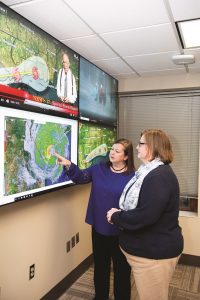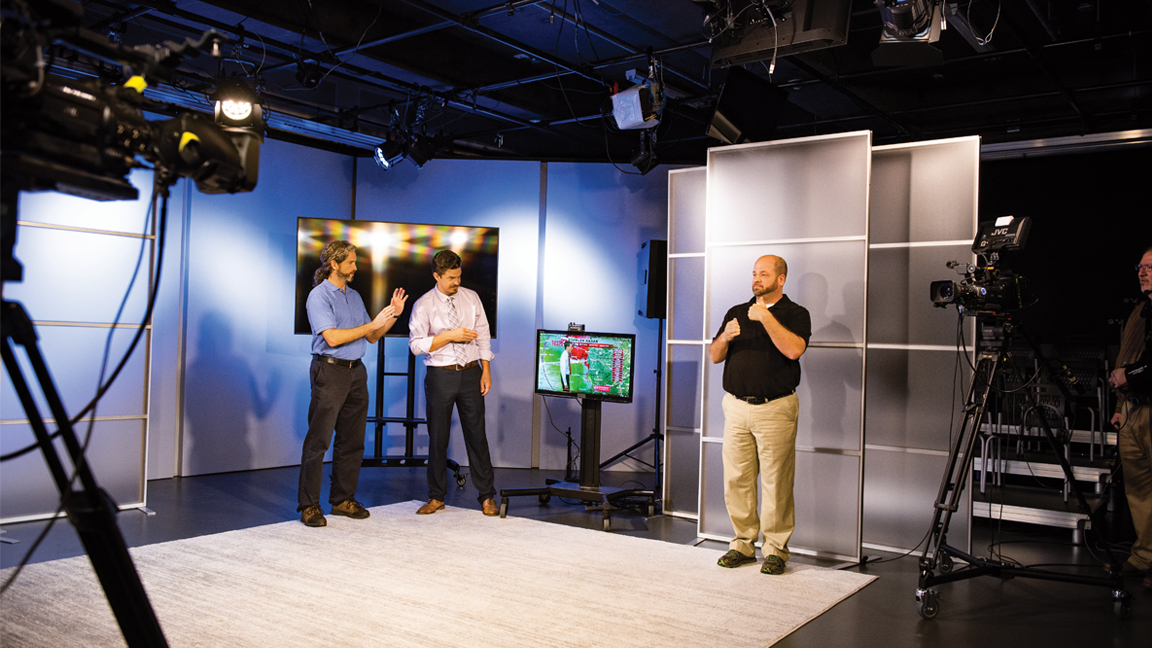
.
Grants help three UA researchers discover new ways to communicate weather alerts
Severe weather emergencies affect millions of people around the world every year. In the past decade, storms like Irma, Sandy, Harvey, Florence and Michael have left a lasting impact on local communities. Tuscaloosa, Alabama, no stranger to severe weather, still bears scars from its tornado super outbreak in April 2011. Whatever the issue—flash flooding, tornadoes, hurricanes or hailstorms—communicating severe weather alerts is at the core of ensuring public safety and saving lives.
Investigating the Message
Understanding how weather alerts work and the varying levels of impact they have on different populations presents a challenge for meteorologists and municipalities alike. What is the most effective medium for their given constituency? And how do they reach less-represented, vulnerable populations within their citizenry? These are the kinds of questions researchers are asking at the College of Communication and Information Sciences, and now they have secured the funding to find the answers.
Dr. Darrin Griffin in UA’s department of communication studies in collaboration with Dr. Jason Senkbeil, UA College of Arts and Sciences, and Dr. Kathy Sherman-Morris, department of geosciences at Mississippi State University, received a grant of more than $250,000 from the National Oceanic and Atmospheric Administration to conduct research on the accessibility and comprehension of tornado warnings among deaf, blind and deaf-blind populations in the southeastern United States.

“Ultimately, what makes blind and deaf populations different is their ability to receive messages,” said Griffin. “At the end of the day, our study is about effective messaging—determining what messaging is working and what isn’t working, and improving that messaging.”
Because these populations receive messages differently, communicating severe weather forecasts presents a unique challenge. Visual charts and diagrams, as well as language commonly employed during broadcasts, do not translate effectively. Griffin’s team wants to change that, making broadcasts more effective for all people.
Drs. Cory Armstrong and Chandra Clark of UA’s department of journalism and creative media are tackling a similar issue. Funded by the Alabama-Mississippi Sea Grant Consortium, their research is investigating the effectiveness of different types of weather alerts and how those messages motivate citizens to action in rural and urban communities.
In both studies, it is the way messages are communicated that matters most. The difference between being in harm’s way or being sheltered and secure may come down to the ability of forecasters and media representatives to understand how people receive messages and what makes them take action.
Improving the Message

Determining how to communicate in ways that best inform particular audiences can be difficult. For each of these studies, the challenges begin with understanding how the audiences process the information and discovering how to change the message in ways that improve their comprehension.
“The first thing we want to know is how people receive severe weather notifications—are they watching television, are they talking to their friends, or are they checking social media?” said Armstrong. “Then we want to try and determine what specific words and visuals motivate them to action and what steps they take to prepare for severe weather.”
Clark developed six different visual elements of weather broadcasts that were shown to cross-sections of the populations in Biloxi and Pearlington, Mississippi, and Mobile and Magnolia Springs, Alabama. From there, Armstrong asked the subjects to evaluate which models would most likely motivate them to seek shelter from a severe weather event, namely tornadoes and hurricanes. Now, Armstrong is analyzing this data to develop guides for broadcasters, media personnel and meteorologists about effective ways to reach rural populations during severe weather outbreaks.
“If we can point out the key words and methods for how to announce severe weather then ultimately we can help save lives,” said Armstrong.
For Griffin, the ultimate hope is to create a system that can utilize existing technology and provide live interpreting in American Sign Language. ASL is a complex language, grammatically different from English and not directly translatable in the way that many English-speaking people assume. During severe weather broadcasts, closed captioning can be unreliable and, even when it is reliable, still fails to appear in ASL users’ primary language. Added to that struggle, weather broadcasts often include scientific language common to English speakers, but less common to ASL users.
To read more, visit cis.ua.edu/.
Contact
Rand Nelson, 205-348-6416, james.nelson@ua.edu
Source
Dr. Darrin Griffin, 205-632-0777, djgriffin1@ua.edu
